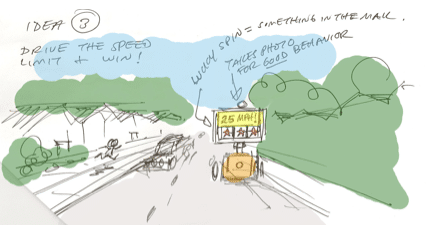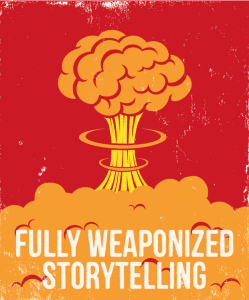I have always been a big fan of The Fun Theory by Volkswagen. It was a brilliant social initiative, created for the German automaker by DDB. It must’ve been difficult (read expensive) to pull off every year, because they are no longer running it. What a shame. Through The Fun Theory, Volkswagen turned mundane, but socially good, experiences – like recycling or taking the stairs instead of the escalator – into positive stories that everyday folks could play a role in.
My first introduction to The Fun Theory was watching the winning entry in 2009 called Piano Stairs. Remember Tom Hanks tap dancing his way through Heart & Soul in the movie BIG? He may have mastered the horizontal keyboard. But Volkswagen wanted to see what would happen with the vertical version.
As I was smittened by The Fun Theory for the way it invited passersby into its stories and made them the hero. I had the good fortune to meet its 2010 winner: Kevin Richardson. Kevin was presenting storytelling and game dynamics at the Sustainable Brands conference, the first time I had attended this gathering of brands working toward the greater good. He shared his ingenious story about how he turned the negative loop of getting a traffic ticket into a positive story by rewarding those who follow the speed limit. He called it, “Speed Camera Lottery.”
Kevin used the same approach to storytelling he relied on as, at the time, a senior producer for MTV’s Nickelodeon Kids & Family Games to create “Speed Camera Lottery.”
“Each of us is the protagonist in our own life. So I wanted to put the single person at the center of this experience. But instead of descending upon them with all of the typical negative reinforcements of cops, tickets and traffic courts, I decided to give this story a twist and positively reinforce them with cash for doing the right thing.”
It’s a real-time game that captures snapshots of all passing license plates and drivers. Those who are obeying the speed limit are entered into a lottery to win cash generated from the ticketed speeders.
A fun way to change behavior

During the promotion, the average speed was reduced by 22 percent.
Here are the nine steps for how he structured the “Speed Camera Lottery” story to appeal to the driving hero in us all.
- Consumer, player, audience, target = Protagonist
- Story Problem (is it one I/we care about?)
- Backstory (what happened before these ideas showed up?)
- Main Character Concern (winning, broadly defined)
- Antagonist (opponent or big brother, “life”)
- Obstacle/Inhibitor Character Concern (status quo, inferior solutions, etc.)
- Story Limit (time or an event)
- Story Outcome (What happens if we do nothing?)
- Ironic Story Premise (get paid for driving the speed limit…)
Kevin told me that one thing is held sacred in making all great stories work, especially if you’re trying to change behavior:
“Whether its a game, fictional entertainment, or real life, you have to care about the outcome to remain engaged.”
Kevin and I have remained good friends online. And he was kind enough to be a guest speaker for my storytelling course in the Executive Masters for Sustainability Leadership at Arizona State University.
You can learn more from Kevin when we launch our new The Business of Story podcast in July. He will be one of our first guests.
My goal with our new show is to help you craft and tell compelling stories that sell – online and off. You will learn from some of the brightest content creators, advertising creatives, authors, professors, makers, marketers and brand raconteurs in the business. Within every show you will learn at least one actionable tip that will make your stories more engaging, and help you advance your personal or professional quest further, faster.
How are your stories engaging your audiences and moving them to action?











at 10:43 am
[…] Volkswagen’s “Fun Theory” was center stage, demonstrating how they crowdsource their customers to come up with the most engaging ideas to affect positive behavior change. I was fortunate to spend time with Kevin Richardson, this year’s winner of the Fun Theory contest with his “Speed Camera Lottery” concept. The stunt turned the negative loop of punishing speeders with tickets and fines into a positive loop of rewarding drivers who obey the speed limit. (You can read more of the story here.) […]
at 4:00 am
I’ll call you early in August.Been gone since July 4 … Seattle, Manhattan and to Binghamton, NY this morning. Home 8/1. Hope all is well with you and family. Very interesting report. Thanks for including me. David
at 4:07 am
Very interesting. Thanks for including me. Leaving NY City in 2 hours, bound for Binghamton, NY. Home 7/31. I’ll call you in early August. Best to you and family. David Stern.
at 5:27 pm
[…] Volkswagen’s “Fun Theory” was center stage, demonstrating how they crowdsource their customers to come up with the most engaging ideas to affect positive behavior change. I was fortunate to spend time with Kevin Richardson, this year’s winner of the Fun Theory contest with his “Speed Camera Lottery” concept. The stunt turned the negative loop of punishing speeders with tickets and fines into a positive loop of rewarding drivers who obey the speed limit. (You can read more of the story here.) […]
at 12:22 pm
[…] after reading several behavior change books like Switch, and listening to the big companies at the Sustainable Brands Conference earlier this year, one thing has become clear to me: Promoting sustainability is about amplifying […]
at 9:42 am
[…] after reading several behavior change books like Switch, and listening to the big companies at the Sustainable Brands Conference earlier this year, one thing has become clear to me: Promoting sustainability is about amplifying […]
at 11:17 pm
Park: Awesome BLOG post. I loved the fun story and your commentary on how to develop your own story cycle. Keep posting to make us smarter. Thank you, Kevin